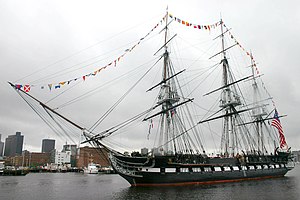Original six frigates of the United States Navy

USS Constitution, the last of the original six frigates of the United States Navy still commissioned.
|
|
| Class overview | |
|---|---|
| Operators: | United States Navy |
| Preceded by: | None |
| Built: | 1794–1800 |
| In commission: | 1797–present |
| Planned: | 6 |
| Completed: | 6 |
| Active: | 1 |
| Lost: | 2 |
| Retired: | 3 |
| General characteristics (Constitution; President; United States) | |
| Class and type: | 44-gun frigate |
| Tonnage: | 1,576 |
| Displacement: | 2,200 tons |
| Length: |
|
| Beam: | 43 ft 6 in (13.26 m) |
| Draft: |
|
| Depth of hold: | 14 ft 3 in (4.34 m) |
| Complement: | 450 officers and enlisted, including 55 Marines and 30 boys |
| General characteristics (Congress and Constellation) | |
| Class and type: | 38-gun frigate |
| Tonnage: | 1,265 tons |
| Length: | 164 ft (50 m) between perpendiculars |
| Beam: | 41 ft (12 m) |
| Complement: | 340 officers and enlisted |
| General characteristics (Chesapeake) | |
| Class and type: | 38-gun frigate |
| Tonnage: | 1,244 |
| Length: | 152.8 ft (46.6 m) between perpendiculars |
| Beam: | 41.3 ft (12.6 m) |
| Draft: | 20 ft (6.1 m) |
| Depth of hold: | 13.9 ft (4.2 m) |
| Complement: | 340 officers and enlisted |
The United States Congress authorized the original six frigates of the United States Navy with the Naval Act of 1794 on March 27, 1794, at a total cost of $688,888.82. These ships were built during the formative years of the United States Navy, on the recommendation of designer Joshua Humphreys for a fleet of frigates powerful enough to engage any frigates of the French or British navies yet fast enough to evade any ship of the line.
After the Revolutionary War, a heavily indebted United States disbanded the Continental Navy, and in August 1785, lacking funds for ship repairs, sold its last remaining warship, the Alliance. But almost simultaneously troubles began in the Mediterranean when Algiers seized two American merchant ships and held their crews for ransom. Minister to France Thomas Jefferson suggested an American naval force to protect American shipping in the Mediterranean, but his recommendations were initially met with indifference, as were the recommendations of John Jay, who proposed building five 40-gun warships. Shortly afterward, Portugal began blockading Algerian ships from entering the Atlantic Ocean, thus providing temporary protection for American merchant ships.
Piracy against American merchant shipping had not been a problem when under the protection of the British Empire prior to the Revolution, but after the Revolutionary War the "Barbary States" of Algiers, Tripoli, and Tunis felt they could harass American merchant ships without penalty. Additionally, once the French Revolution started, Britain began interdicting American merchant ships suspected of trading with France and France began interdicting American merchant ships suspected of trading with Britain. Defenseless, the American government could do little to resist.
...
Wikipedia
